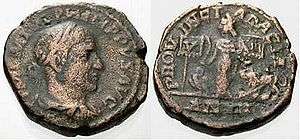247
Year 247 (CCXLVII) was a common year starting on Friday (link will display the full calendar) of the Julian calendar. At the time, it was known as the Year of the Consulship of Philippus and Severus (or, less frequently, year 1000 Ab urbe condita). The denomination 247 for this year has been used since the early medieval period, when the Anno Domini calendar era became the prevalent method in Europe for naming years.
| Millennium: | 1st millennium |
|---|---|
| Centuries: | |
| Decades: | |
| Years: |
|
| 247 by topic |
|---|
| Leaders |
| Categories |
|
| Gregorian calendar | 247 CCXLVII |
| Ab urbe condita | 1000 |
| Assyrian calendar | 4997 |
| Balinese saka calendar | 168–169 |
| Bengali calendar | −346 |
| Berber calendar | 1197 |
| Buddhist calendar | 791 |
| Burmese calendar | −391 |
| Byzantine calendar | 5755–5756 |
| Chinese calendar | 丙寅年 (Fire Tiger) 2943 or 2883 — to — 丁卯年 (Fire Rabbit) 2944 or 2884 |
| Coptic calendar | −37 – −36 |
| Discordian calendar | 1413 |
| Ethiopian calendar | 239–240 |
| Hebrew calendar | 4007–4008 |
| Hindu calendars | |
| - Vikram Samvat | 303–304 |
| - Shaka Samvat | 168–169 |
| - Kali Yuga | 3347–3348 |
| Holocene calendar | 10247 |
| Iranian calendar | 375 BP – 374 BP |
| Islamic calendar | 387 BH – 386 BH |
| Javanese calendar | 125–126 |
| Julian calendar | 247 CCXLVII |
| Korean calendar | 2580 |
| Minguo calendar | 1665 before ROC 民前1665年 |
| Nanakshahi calendar | −1221 |
| Seleucid era | 558/559 AG |
| Thai solar calendar | 789–790 |
| Tibetan calendar | 阳火虎年 (male Fire-Tiger) 373 or −8 or −780 — to — 阴火兔年 (female Fire-Rabbit) 374 or −7 or −779 |

Sestertius minted in 247 by Philip the Arab to celebrate Dacia province and its legions, V Macedonica and XIII Gemina. Note the eagle and the lion, V's and XIII's symbols, in the reverse.
Events
By place
Roman Empire
- Rome becomes 1,000 years old.
- Marcus Julius Philippus Augustus and his 10-year-old son Marcus Julius Philippus Caesar become Roman Consuls.
- The Goths appear on the lower Danube frontier; they invade the Ukraine and Romania.
- Emperor Philip the Arab marks the millennium of Rome by holding the Ludi Saeculares.
- The last of the two Councils of Arabia in the Roman Christian Church is held in Bostra, Arabia Petraea.
Japan
- Himiko of Yamataikoku, in Japan, begins a war against King Himikoku of Kunukoku.[1]
Deaths
- Bu Zhi, Chinese statesman and general of the Eastern Wu state[4]
- Zhang Chunhua, wife of Sima Yi, prominent military general and regent of the state of Cao Wei (b. 189)
gollark: Well, it completely ignores their position in the document.
gollark: What do you mean "what about order"?
gollark: Variety?
gollark: There's a brief description of its function on the main page there.
gollark: As well as zlib-compressed page content, domain metadata, robots.txt, search history, and an index of all links, it has to store an "inverted index" mapping tokens to pages.
References
- Walker, Brett L. (2015). A Concise History of Japan. Cambridge University Press. p. 18. ISBN 9781107004184.
- "List of Rulers of Korea". www.metmuseum.org. Retrieved April 21, 2019.
- Song, Geng (2004). The Fragile Scholar: Power and Masculinity in Chinese Culture. Hong Kong University Press. p. 143. ISBN 9789622096202.
- Biographical Dictionary of Chinese Women: Antiquity Through Sui, 1600 B.C.E.-618 C.E. M.E. Sharpe. 1998. p. 272. ISBN 9780765641823.
This article is issued from Wikipedia. The text is licensed under Creative Commons - Attribution - Sharealike. Additional terms may apply for the media files.